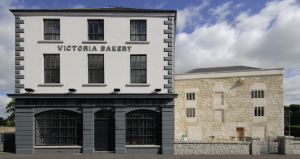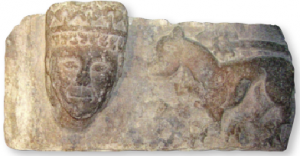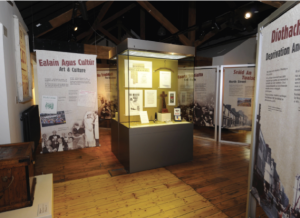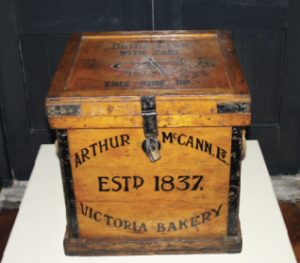Museum Eye
Published in Issue 5 (September/October 2013), Medieval History (pre-1500), Reviews, Volume 21
The museum is located in premises vacated by McCann’s Bakery in 1996 (original façade on the left), underneath which was revealed Nicholas Bagenal’s castle (right).
I first wrote about the Newry museum for this column in 2005. There have been many changes since then. As some readers may know, my first job was as the museum officer in Newry, when I opened the new museum in a converted nineteenth-century coal merchant’s office as part of the arts centre. The museum now has a new home on the site of the original Newry Abbey, on a hill overlooking the city. After its dissolution in the sixteenth century, the abbey was taken over by Nicholas Bagenal, who built a castle there. Bagenal’s Castle survived through the centuries and in the nineteenth was incorporated into the premises of McCann’s Bakery.

Look out for the fifteenth-century carved window decoration of a lady’s head and a lion from Newry’s Cistercian abbey.
It was rediscovered when the bakery was closed down in 1996 during redevelopment work. Locals had always suspected that the ancient walls inside the bakery were the remains of the old castle, although archaeologists had refused to accept this. In an enlightened decision, Newry and Mourne District Council acquired the site and took the opportunity to preserve and restore one of the most important aspects of the city’s heritage. The building is of significance not just because of its history but also because it is the only known surviving Irish castle for which the original plans still exist (in the National Archives in London). The district council restored and developed the castle and an adjoining house as the new museum. This flagship project provides a top-class museum service—an education officer, lecture programme and workshops, for example—and is a focus for cultural, heritage and tourism activities.
The museum manages that difficult task of providing modern facilities while preserving the character of the old buildings. A lift has been discreetly installed alongside the stairs, allowing access to all floors. The reception is on the ground floor of the old McCann’s Bakery, and from there time-lines and panels guide the visitor through the museum’s galleries. There is not too much in the way of hi-tech gadgets but there are interactive displays and costumes for schoolchildren to try on. The large panels throughout not only give information on local and national chronology but also add atmosphere and colour. Unusually for a museum in Northern Ireland, all the information throughout is in both Irish and English. The corridors between galleries are decorated with black-and-white photographs recalling Newry and Mourne in the nineteenth and twentieth centuries. Two of these galleries are in the original castle and its remains can be seen in the various architectural features left exposed, such as a chimney or (appropriately enough) a medieval bread oven. There is also a restored banqueting hall, which can be used for lectures or other events.

Unusually for a museum in Northern Ireland, all the information throughout is in both Irish and English.
The ground-floor gallery has archaeological artefacts from ancient times to the early modern period. The main theme here is the history of the town up to the Plantation. It takes in the Cistercian monastery around which Newry grew, the Gaelic resistance to English rule and the take-over of Newry by the Bagenal family. Look out for the fifteenth-century carved window decoration of a lady’s head and a lion. Don’t be put off going into rooms that appear to be in the dark. The museum is so advanced that lights come on as you approach them and go off when you leave.
The second gallery may be described as celebrating Newry’s golden age, after the opening of the canal to Lough Neagh. The wealth and culture of the town is reflected in items such as eighteenth-century glassware, a long case clock and the regalia of the Order of St Patrick, which belonged to the town’s landlord. Here, too, models and panels add depth to the story of Newry’s growth.
Upstairs, the ‘Border Town’ gallery reflects the history of the area with a display of household, agricultural and industrial artefacts. Here there are an old cane pram, clothes, a spinning wheel, posters of local firms, whiskey bottles, a pair of tailor’s scissors and many more objects belonging to local industries. Where possible, every object is linked to a particular person, business or story. McCann’s Bakery is not forgotten, with a cabinet full of memorabilia from this venerable business and also an impressive wooden wedding-cake box on show. This gallery also takes in the two world wars, the struggle for independence, partition and the Troubles. Items, photographs and reminiscences of all these major events are well represented in the display cabinets and panels here. The story ends with the charter which elevated Newry to city status in 2002 as part of Elizabeth II’s jubilee celebrations.
I leave Bagenal’s Castle with the impression that this is a lively museum. As well as the permanent galleries there are temporary exhibitions, such as the current one on brotherhoods and friendly societies in Newry and Mourne. One satisfied tour was leaving as I arrived, and these are even run on Sundays now. There is a busy publishing programme, with information leaflets, pamphlets and books on the exhibitions and aspects of local history. There must be hundreds of objects on display from the Neolithic period to the 21st century, reflecting the long and varied history of the city and its neighbourhood. It has come a long way from those early days as a wing of the arts centre. The modern museum is well resourced, with proper storage facilities, a workshop and lab for the best care of the objects in its possession. It is also in an appropriate home, which in itself is a historic and symbolic building. HI

















